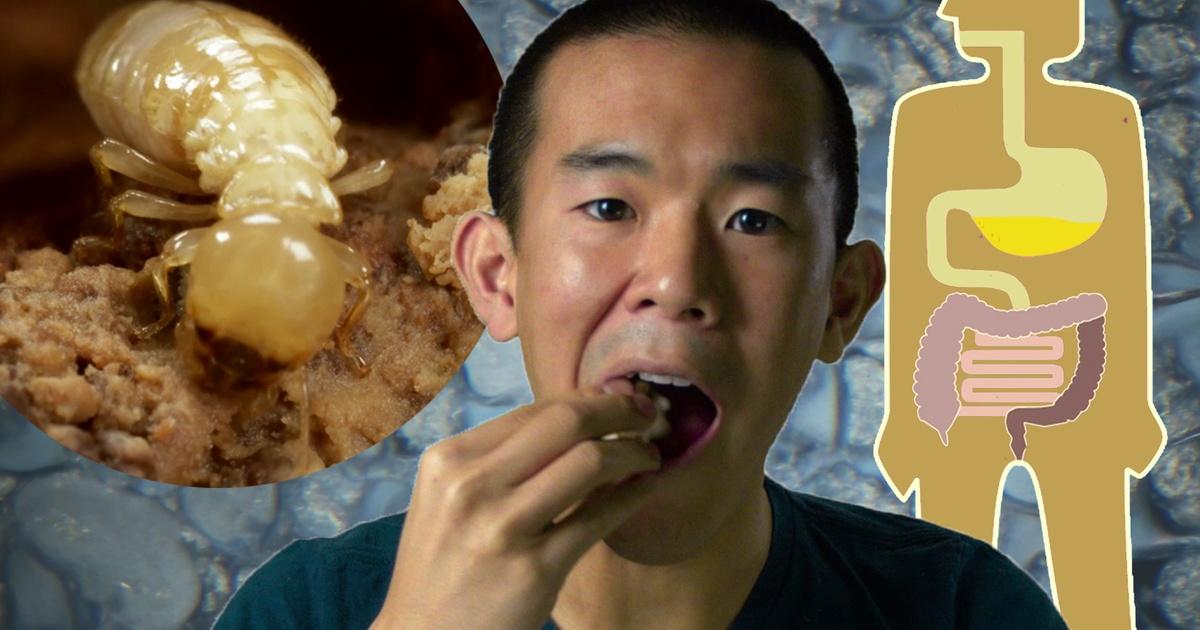Play all audios:
[sounds of bubbles] ["ta da" sound] ED YONG: Do you ever have those days when you just can't stop eating? [sounds of biting and chewing] What's up with that? And more
importantly, what happens to all that food? [sound of film reel] FILM NARRATOR: This is digestion. Food matter enters one end of the tube. Along the way, bigger pieces of food are broken
down into smaller ones, dissolved, and nutrients and energy-bearing molecules are absorbed. The rest is expel-- All right, all right. But eating is actually much more complicated than that,
and animals typically cannot do it alone. Especially when it comes to plants. [sound of biting carrot] Plants consist of a complex range of carbohydrates, and we typically lack the enzymes
necessary to break all that down, and so we need help, and we get that help from microbes. They are masters of biochemistry. They do have the right enzymes necessary to digest something like
this, which is why the digestive tracts of many animals are full of microbes. When we eat, they help usto digest the indigestible, to break down our food so that we can get nutrients from
it. These kinds of partnerships go back hundreds of millions of years, and they have shaped the evolution of the animal digestive system. I think we're learning more and more that we
rely on gut microbes for-- to help us digest our food. This is Xinning Zhang, from Princeton University. I am an environmental microbiologist, but within that sort of very vague, umbrella
term, I would say I'm a microbe person. Hey, me too. XINNING: I think of the microbes as the underdogs in our world. They were the first life forms on earth, and I'm sure
they're going to be the last ones on earth. [laughter] So I'm really interested in just understanding how they work, why they do the things they do. For example, why are they so
important for termite guts? ED: Well, I-- [sound of biting clothespin] I imagine that eating wood would require some serious teamwork. XINNING: Yes, yeah. Termites and their gut microbes are
really two sides of the coin. The termites have their gut microbes to help them do the job of living on a, and feeding on a, very difficult to digest food. ED: But the process begins with a
termite and its jaws. XINNING: You start with the termite chomping on the wood and breaking into small particles. They're just basically macerating the wood into, like, sawdust. ED:
The bits of wood are the bright brown chunks in this microscope video of the guts of a termite. The large clear blobs are protists. They are microbes, but their complex cells are more
similar to our own than to bacteria. These protists engulf the wood particles, and then get to work digesting them. XINNING: The wood is broken down into little molecules to access the yummy
sugars, which can be used, ultimately, to feed the termite. Right, and everyone-- the microbes and the termite itself, everyone-- [sound of biting apple] gets a meal. Everybody gets fed.
Everybody does their fair share of work, let's say. And so-- [sound of biting pretzel] How does that partnership evolve? [music playing] XINNING: It turns out that termites actually
evolved from a cockroach, an omnivorous cockroach, like the ones you might find in your house. ED: Oh, right, like the ones I try unsuccessfully to kill. Eww! [sound of breaking glass]
[laughter] [sounds of dinosaurs] XINNING: I guess it was in the Jurassic, about 150 millions years ago, it turns out that the social behavior of the cockroaches allowed these omnivorous
cockroaches to basically take advantage of another food source-- in a varied, abundant food source-- that being wood. [music playing] These, let's say, wood-feeding cockroaches, and
then termites, they're able to inoculate their young with gut microbes. So this, basically, you can think of them as being able to transfer the potential to eat wood to the next
generation, and so forth and so forth and so forth. So you're saying that they're passing along the microbes that they need to digest wood through social behavior? Yes, enabled by
a social behavior. Yes, exactly. And how, exactly, do termites do social? So how do they do that? Oh, it's a term that's called-- the technical term is called proctodeal
trophalaxis. And basically it's hmm. So-- Like, proc-- is there a doctor proctologist? Uh, proctologist? That, yeah, that. Proctodeal trophalaxis. Right, and trophalaxis means when
animals feed with regurgitated fluids, so-- I guess you want me to say the word butt. I am. I am trying to get you to say butt. That is exactly what I'm trying to do. So really, the way
in which termites pass on these microbes from one to another is through butt-licking. Exactly. [laughter] So there is a little blob of the gut fluid that comes out from the end, the
posterior, of one termite, and another termite-- some of the juvenile termites-- will eat that. And it's full of nutritious, tasty, you know, microbes in there, and-- Ah, which allow
them to digest wood! So really, this is a superpower bestowed by intergenerational butt-licking. Yes, exactly. [music playing] XINNING: The fact is that one organism can't do
everything, right? Just like one person can't do everything. At some point, you have to outsource some of the functions. Very true, like ordering takeout. [sounds of eating] [music
playing]

